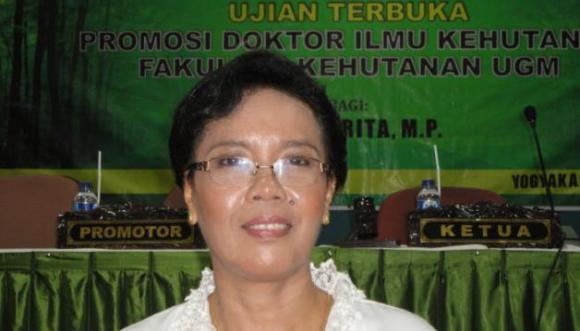
Peat land use activities that are not managed wisely become a source of peatland forest destruction resulting in socio-economic and cultural losses in the surrounding communities, as well as for the wider environment. As in the Peatland Development Project (PLG) one million hectares for agriculture in the Middle Kalimantan in 1995.
With the creation of drainage divides have caused damage to the peat dome of peat forest were exceptional. PLG project eventually was terminated based on Presidential Decree No. 80 in 1998. To handle this region PLG former government issued Presidential Decree No. 80 of 1999 on General Guidelines for Planning and Management of PLG in Central Kalimantan.
“One of the goals of the decree is to prepare the concept of rehabilitation of ex PLG region with emphasis on the empowerment and welfare of the community through the development potential in the region,” said Ir. Yanarita., MP, at the Faculty of Forestry UGM, Friday (27/6).
Yunarita mentioned, the issuance of Presidential Decree No. 2/2007 on the Acceleration of Rehabilitation and Revitalization of ex PLG in Central Kalimantan to provide an alternative that can be done to rehabilitate the area. Among them rebuild the natural regeneration of natural forests, plantations and building a community forest.
“Based on the decision of the Director General RLPS No. 028 / KPTS / V / 2001 dated July 17, 2001, it is a community forest is a growing field trees on property rights and other rights to the provision of a minimum area of 0.25 hectares and is characterized by crown cover woody plants of more than 50 percent or crop the first year at least 500 trees per hectare, “said the lecturer of the Department of Forestry, Faculty of Agriculture, University of Palangkaraya while defending his dissertation” Development Strategy of Forest People For Reahabilitasi Peatlands in Central Kalimantan “in promotion open Doctoral Program Division of Forestry Sciences UGM.
It is said Yunarita, community forests are basically not new in people’s daily life with a variety of different designations. For example, in Java called talun, in West Kalimantan tembawang, and in Lampung Krui called rempong resin.
Meanwhile, in Central Kalimantan PLG also met people from the cultivation of forest woody plants by local people called kabun. Generally, kabun a rotational cultivation dominated by rubber tree (Hevea brasilliensis) mixed with plant varieties of fruits like rambutan (Nephelium mutabile), durian (Durio zibentinus), jackfruit (Arthocarpus sp.), Duku (Lansium domesticum corr.) , banana (Parthian speciosa), and others.
Yunarita explained, people actually take advantage of peat by using the cropping pattern which they apply in accordance with the characteristics of the land that it faces. Even ex-PLG peat land in Central Kalimantan also for transmigration destination areas in an effort to develop the region.
“So those who have farming skills in the area of origin, utilizing peat use cropping pattern but to adjust to the conditions encountered. Unfortunately information community forest management in peat areas is very limited. While the use of peatlands for community forests in processing different from the processing area community forests on mineral soil “, he said.
According Yunarita, land preparation for planting on peat habitat is relatively harder than the mineral soil. This is due in less fertile peat habitat (nutrient-poor), the nature of the high acidity (pH 3-5), the thickness of the peat so varies from shallow to deep, condition and degree of weathering and water-logging will treat various of engineering land preparation, planting and maintenance techniques.
“Therefore, the forest people who built the local community and migrants in the region of ex PLG peat remains an interesting study to prepare the strategic concept of rehabilitation of ex PLG peat land in Central Kalimantan which has been damaged,” he said. (UGM / General)
